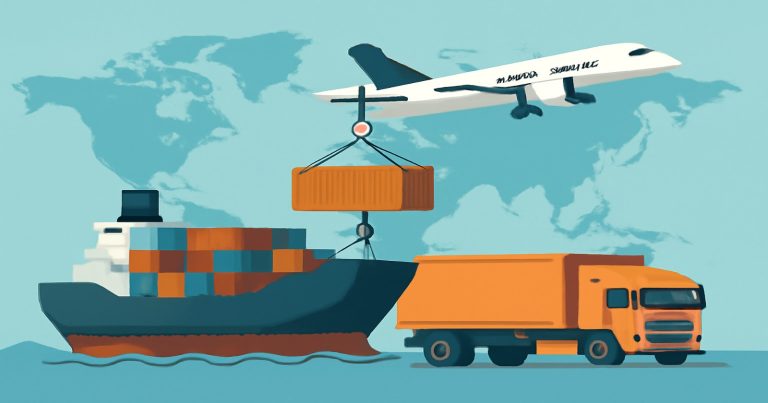Exportation plays a crucial role in global trade, enabling businesses to expand their markets beyond national borders. The term exportation refers to the process of sending goods or services from one country to another for sale or trade. This practice has been fundamental to international commerce for centuries, allowing countries to access new markets, generate revenue, and strengthen their economies. In today’s highly interconnected world, exportation remains a vital strategy for businesses looking to grow and thrive. For countries, successful exportation can lead to increased foreign exchange earnings, job creation, and industrial growth. However, navigating the complexities of exportation requires a thorough understanding of its processes, regulations, and market dynamics.
Exportation Definition in Commerce
Exportation is the act of sending goods or services from one country to another for the purpose of trade. It involves more than just the physical movement of products; it encompasses various stages, including production, documentation, transportation, and compliance with legal and regulatory standards. Exportation serves as a crucial vehicle for global trade, enabling businesses to access foreign markets, diversify their customer base, and increase their revenue streams.
In practice, exportation can involve a wide range of products—from manufactured goods to agricultural products and services like software, consulting, or education. For businesses, understanding the exportation process is vital, as it opens up opportunities to scale operations and gain a competitive edge on the global stage.
Historical Evolution of Exportation
The practice of exportation has a long and rich history that dates back to ancient civilizations. Initially, trade between regions was limited to basic goods such as spices, silk, and precious metals. Over the centuries, the methods, routes, and scope of exportation have evolved dramatically. From the ancient trade routes like the Silk Road to the establishment of modern international trade systems, exportation has played a crucial role in shaping the global economy. The Industrial Revolution further accelerated the development of exportation, enabling mass production and the creation of global supply chains.
Early Trade Routes
Exportation began with ancient civilizations, where goods like spices, silk, and precious metals were traded across vast networks such as the Silk Road and Trans-Saharan routes. These exchanges established the foundation of global trade and cultural diffusion.
Industrial Revolution’s Impact
The industrial revolution mechanized production, drastically increasing the scale of exportation. Steamships and railroads allowed goods to move faster and in greater quantities, transforming local producers into global suppliers.
Modern-Day Exportation
Today, exportation is driven by advanced logistics, digital trade platforms, and global partnerships. Trade agreements such as NAFTA and the European Union’s single market have streamlined the exportation process, promoting international economic collaboration.
Exportation vs. Export: Understanding the Difference
While the terms “exportation” and “export” are often used interchangeably, there are subtle differences between the two:
- Exportation refers to the process or act of shipping goods or services abroad.
- Export refers to the actual goods or services that are being sent to another country.
This distinction is crucial for businesses and governments as they develop strategies and policies around international trade. Understanding the difference ensures that companies correctly handle the logistics and legalities involved in exporting goods and services to foreign markets.
The Exportation Process: A Step-by-Step Guide
The process of exportation can be broken down into several key stages. Each step is critical to ensuring a smooth and successful transaction, from market research to payment collection. Here’s a detailed look at the process:
- Market Research: Before embarking on exportation, businesses need to conduct research to identify target markets and understand the demand for their products. This includes studying consumer behavior, local regulations, and competition in foreign markets.
- Product Adaptation: Depending on the market, products may need to be adapted to meet local regulations, cultural preferences, or consumer needs. This could include packaging changes, formulation alterations, or size adjustments.
- Documentation: Exportation requires a range of documents, including invoices, packing lists, certificates of origin, and export licenses. Proper documentation is crucial for smooth customs clearance and compliance with regulations.
- Logistics: Arranging transportation, warehousing, and delivery is essential. Companies need to determine the best mode of transport (e.g., air, sea, land), optimize routes, and ensure timely delivery.
- Customs Clearance: To legally ship goods abroad, businesses must comply with customs regulations in both the exporting and importing countries. This includes paying duties, taxes, and following import restrictions.
- Payment Collection: Exporters need to ensure secure payment methods, such as letters of credit or international bank transfers, to guarantee they receive payment for their goods.
Each of these stages requires careful planning and attention to detail to ensure a successful exportation process.
Legal and Regulatory Framework in Exportation
Exportation is governed by numerous laws and regulations, both domestic and international. These rules are designed to ensure that goods move smoothly across borders and comply with safety, security, and trade requirements.
- Export Controls: Some products may be restricted for export due to national security concerns or compliance with international treaties. For example, certain technologies or military equipment may require special export licenses.
- Customs Regulations: Every country has its own customs regulations that dictate how goods must be packaged, labeled, and documented. Exporters must be familiar with the specific requirements of the countries they are exporting to.
- Trade Agreements: Bilateral or multilateral trade agreements between countries can provide preferential access to certain markets. These agreements often reduce tariffs and provide protections for exporters.
Understanding the legal and regulatory framework is vital to avoid delays, fines, or potential legal issues when exporting goods.
Economic Significance of Exportation
Exportation has a profound impact on both the economy of the exporting country and the global economy. For the country, it is a significant driver of economic growth as it facilitates access to larger markets, which in turn increases national production levels. When companies export, they earn foreign exchange, which can be used to finance imports and stabilize the national currency. Moreover, exportation creates employment opportunities, particularly in industries related to manufacturing, logistics, and international finance. When businesses engage in exportation, they contribute to national growth in several ways:
- Economic Growth: Exportation allows countries to reach larger markets, which in turn increases production capacity and national income.
- Foreign Exchange Earnings: Exports bring in foreign currency, which is essential for importing goods, stabilizing the national currency, and strengthening the balance of payments.
- Job Creation: Export industries often require large workforces for production, shipping, and compliance, leading to job creation and economic stability.
- Innovation and Technology Transfer: Exposure to global markets encourages innovation and the adoption of new technologies, driving economic modernization.
For businesses, exporting opens doors to new revenue streams, greater brand recognition, and access to more competitive markets.
Challenges in Exportation
While exportation offers numerous benefits, it is not without its challenges. One of the major hurdles faced by exporters is dealing with cultural differences. Understanding and respecting the local customs, preferences, and business practices of foreign markets is essential for successful market penetration. Some of the most common obstacles include:
- Cultural Differences: Different cultures and consumer preferences can make it difficult for businesses to succeed in foreign markets without significant research and adaptation.
- Logistics and Supply Chain Issues: Coordinating transportation, inventory management, and product delivery across international borders can be complex and costly.
- Regulatory Barriers: Navigating the complex regulatory environments of different countries can be overwhelming. Exporters need to stay compliant with each country’s specific trade rules and regulations.
- Currency Fluctuations: Currency exchange rates can impact the profitability of export transactions, particularly for businesses that operate in multiple currencies.
By recognizing these challenges, businesses can develop strategies to mitigate risks and ensure successful export ventures.
Strategies for Successful Exportation
To thrive in international markets, businesses must adopt strategies that mitigate the risks and challenges of exportation. One effective strategy is to conduct thorough market research, allowing businesses to understand the dynamics of foreign markets, consumer preferences, and potential competitors. To overcome challenges and succeed in exportation, businesses should implement effective strategies:
- Market Research: A deep understanding of foreign markets and consumer behavior is essential. Tailoring products to suit local preferences can help businesses gain a competitive edge.
- Risk Management: Exporters should utilize financial instruments like hedging to protect against currency fluctuations and other financial risks.
- Quality Control: Ensuring consistent product quality is crucial for building a reputable brand in foreign markets.
- Building Strong Relationships: Cultivating good relationships with international clients and distributors can help businesses secure repeat business and referrals.
- Leveraging Export Credit Agencies: Export Credit Agencies (ECAs) offer financing, insurance, and advisory services that can help businesses expand their reach and reduce risk.
By following these strategies, businesses can significantly improve their chances of success in global markets.
Exportation Documents and Their Importance
Documentation is crucial in exportation to ensure transparency, compliance, and smooth operations. Key documents include:
| Document Type | Purpose |
|---|---|
| Export License | Legal permission to export goods. |
| Commercial Invoice | Details of the transaction and payment. |
| Certificate of Origin | Confirms where the goods were manufactured. |
| Packing List | Provides details of the contents and weight. |
| Bill of Lading | Serves as proof of shipment. |
Benefits of Exportation
Exportation offers numerous advantages that extend beyond just financial gains for businesses. By tapping into international markets, companies can significantly expand their reach and diversify their revenue streams, reducing dependency on local markets. This not only fosters growth but also enhances competitiveness on a global scale.
For Businesses
- Market Diversification: Exportation reduces dependence on domestic markets and mitigates risks associated with local economic downturns.
- Increased Revenues: By tapping into foreign demand, companies expand their customer base and enhance profitability.
- Competitive Edge: Exposure to global markets pushes businesses to innovate and improve their products.
For Economies
- Economic Growth: Exportation stimulates industrial activity, driving GDP growth.
- Strengthened Global Ties: Trade fosters diplomatic and economic relationships between nations.
- Technology Transfer: Exportation often includes sharing advanced technologies and practices.
Exportation Benefits FAQs
1. What is the difference between exportation and export?
Exportation refers to the process of sending goods or services abroad, while export refers to the actual goods or services being shipped.
2. What are the key challenges in exportation?
Common challenges include cultural differences, logistical complexities, regulatory compliance, and currency fluctuations.
3. How can businesses manage the risks of exportation?
Businesses can manage risks through market research, financial hedging, quality control, and building strong relationships with international clients.
4. What role do Export Credit Agencies play in exportation?
Export Credit Agencies provide financing, insurance, and advisory services to support exporters, particularly small and medium-sized enterprises.
5. Why is exportation important for a country’s economy?
Exportation boosts economic growth, generates foreign exchange earnings, creates jobs, and fosters technological innovation.


